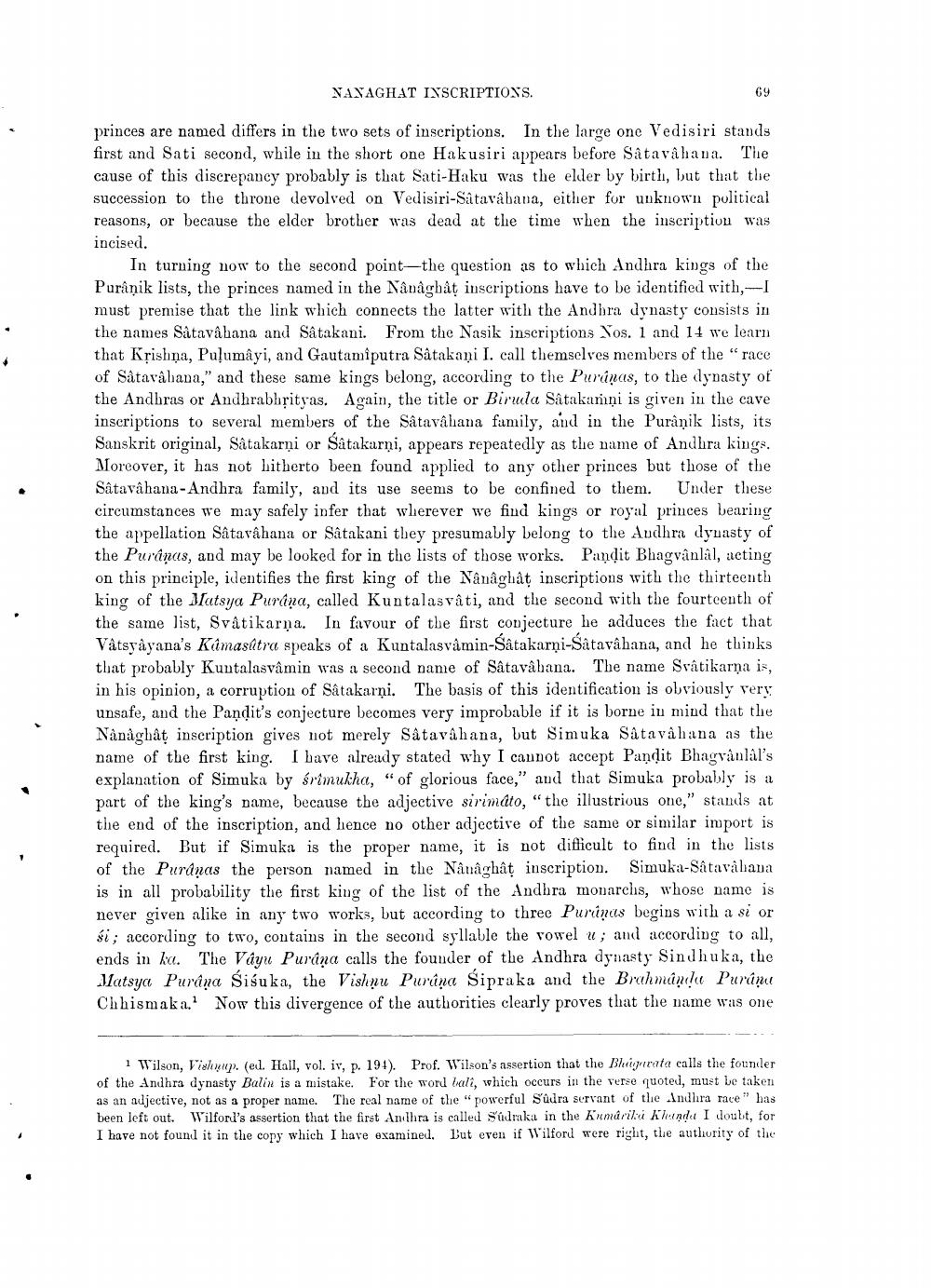________________
NAYAGHAT IXSCRIPTIOXS.
princes are named differs in the two sets of inscriptions. In the large one Vedisiri stands first and Sati second, while in the short one Hakusiri appears before Satavahana. The cause of this discrepancy probably is that Sati-Haku was the elder by birth, but that the succession to the throne devolved on Vedisiri-Satavâbana, either for unknown political reasons, or because the elder brother was dead at the time when the inscription was incised.
In turning now to the second point-the question as to which Andhra kings of the Purâņik lists, the princes named in the Nânågbåt inscriptions have to be identified with,--I must premise that the link which connects the latter with the Andhra dynasty consists in the names Satavahana and Satakani. From the Nasik inscriptions Nos. 1 and 14 we learn that Krishna, Puļumâyi, and Gautamiputra Såtakani I. call themselves members of the "race of Satavâliana," and these same kings belong, according to the Purúņas, to the dynasty of the Andhras or Andhrabbrityas. Again, the title or Birua Satakamņi is given in the cave inscriptions to several members of the Sâtavâliana family, and in the Puranik lists, its Sanskrit original, Satakarņi or Satakarņi, appears repeatedly as the name of Andhra kinys. Moreover, it has not hitherto been found applied to any other princes but those of the Satavahana-Andhra family, and its use seems to be confined to them. Under these circumstances we may safely infer that wherever we find kings or royal princes bearing the appellation Satavahana or Satakani they presumably belong to the Andhra dyuasty of the Puranas, and may be looked for in the lists of those works. Pandit Bhagvânlal, acting on this principle, identifies the first king of the Nânâghåt inscriptions with the thirteenth king of the Matsya Purana, called Kuntalasvati, and the second with the fourteenth of the same list, Svậtikarņa. In favour of the first conjecture he adduces the fact that Vâtsyâyana's Kimasútra speaks of a Kuntalasvâmin-Śâtakarņi-Satavahana, and he thinks that probably Kuntalasvâmin was a second name of Satavahana. The name Svâtikarņa is, in his opinion, a corruption of Satakarņi. The basis of this identification is obviously very unsafe, and the Pandit's conjecture becomes very improbable if it is borne in mind that the Nànåghat inscription gives not merely Satavahana, but Simuka Satavahana as the name of the first king. I have already stated why I cannot accept Pandit Bhagvånlal's explanation of Simuka by srimukha, " of glorious face," and that Simuka probably is a part of the king's name, because the adjective sirimato, "the illustrious one," stands at the end of the inscription, and hence no other adjective of the same or similar import is required. But if Simuka is the proper name, it is not difficult to find in the lists of the Puranas the person named in the Nânâghât inscription. Simuka-Satavalana is in all probability the first king of the list of the Andhra monarchis, whose name is never given alike in any two works, but according to three Puriņas begins with a si or ši; according to two, contains in the second syllable the vowel u; and according to all, ends in ka. The Vayu Purâna calls the founder of the Andhra dynasty Sindhuka, the Matsya Purana Sisuka, the Vishnu Purana Sipraka and the Brahmânila Purúņu Chhismaka. Now this divergence of the authorities clearly proves that the name was one
1 Wilson, Vishwun. (ed. Hall, vol. iv, p. 194). Prof. Wilson's assertion that the Bharata calls the founder of the Andhra dynasty Balin is a mistake. For the word bali, which occurs in the verse quoted, must be taken as an adjective, not as a proper name. The real name of the "powerful Sadra servant of the Indlira race" has been left out. Wilford's assertion that the first Anithra is called Sudraka in the Kumariki kuna I doubt, for I have not found it in the copy which I have examined, but even if Wilford were right, the authority of the




